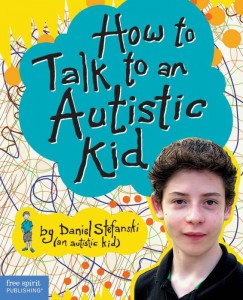5 great nonfiction books about disability written by kids
by Beth
Our librarian is back! Last month Cynthia Fordham wrote a guest post with a list of some of her favorite fiction written from the perspective of young people with disabilities. This time she’s recommending non-fiction books written from the perspective of a child who has a disability.
Learn about disabilities from an expert’s point of view
by Cynthia Fordham
 I have long been on the lookout for books by and for children with disabilities. If you look hard enough, they are out there! Here are five of my favorite non-fiction books written from the perspective of a child whose experience is colored by being differently abled.
I have long been on the lookout for books by and for children with disabilities. If you look hard enough, they are out there! Here are five of my favorite non-fiction books written from the perspective of a child whose experience is colored by being differently abled.
- How to Talk to an Autistic Kid by Daniel Stefanski (Free Spirit Publishing, 2011) is a social skills guide aimed at helping kids without autism get to know kids with autism. Daniel, 14, explains why kids with autism might not respond, make eye contact, repeat themselves, or stand too close. He explains these behaviors in a way that makes sense and won’t “scare off” other kids.
- Leslie’s Story: A Book about a Girl with Mental Retardation by Martha McNey (Lerner, 1996) is one of a series of books published by Lerner that present first-person children’s accounts of disabilities. Leslie describes her daily activities, including being mainstreamed in middle school and how she feels about teasing. All of the books in this series are presented in a similar fashion, and the disabilities include autism, rheumatoid arthritis, blindness, and hearing impairment.
- Blueberry Eyes by Monica Driscoll Beatty (Health Press, 1996) describes the experiences of Meagan, a little girl born with vision problems, including weak eye muscles and extreme farsightedness. The book addresses several vision issues, including wearing glasses and eye patches, or having eye muscle surgery. It describes the operation Meagan needed to see, and how she felt before, during, and after surgery. This book is comforting for a child facing different treatments for vision.
- Taking Asthma to School by Kim Gosselin (JayJo Books, 1995) explains the basics of asthma. From medications to triggers to asthmatic episodes, this book provides plenty of information to educate children on playing with friends and schoolmates who have asthma.
- Jumpin’ Johnny Get Back to Work!: A Child’s Guide to ADHD/Hyperactivity by Michael Gordon (GSI Publications, 1998) is an excellent explanation for children who are diagnosed with ADHD. The book presents everything from Johnny’s point of view, including behaviors, diagnosis, treatments, and tips to help stay focused, as well as how he felt throughout the entire process.
Some of these books are older, but every title is available. A search on the Internet should help locate them, and you may also want to see whether your local library has them. Enjoy!
Cynthia Fordham is a Children’s Librarian at the Woburn Public Library in Woburn, Mass. Her lifelong hearing impairment gives her first-hand knowledge of the challenges that go along with disabilities.






